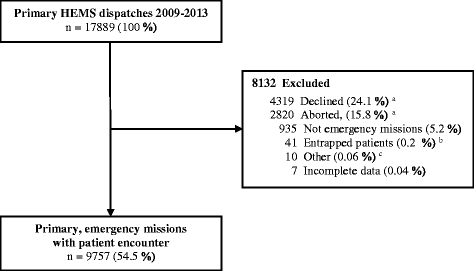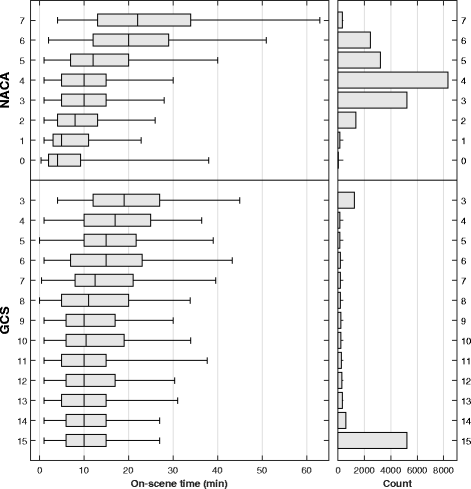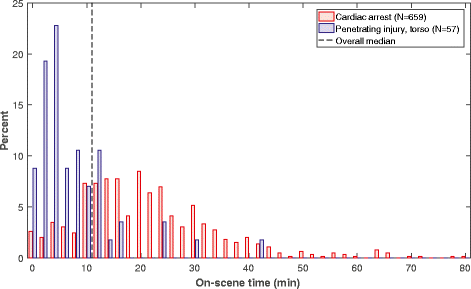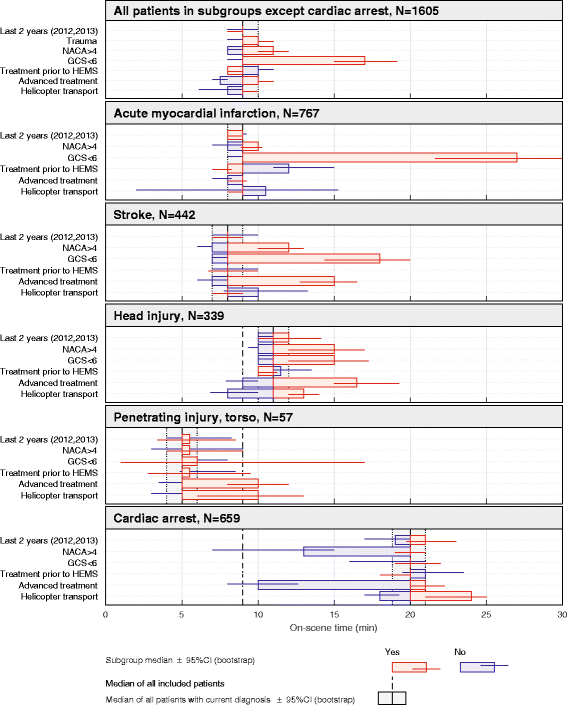Factors influencing on-scene time in a rural Norwegian helicopter emergency medical service: a retrospective observational study
- PMID: 28934985
- PMCID: PMC5609050
- DOI: 10.1186/s13049-017-0442-5
Factors influencing on-scene time in a rural Norwegian helicopter emergency medical service: a retrospective observational study
Abstract
Background: Critically ill patients need to be immediately identified, properly managed, and rapidly transported to definitive care. Extensive prehospital times may increase mortality in selected patient groups. The on-scene time is a part of the prehospital interval that can be decreased, as transport times are determined mostly by the distance to the hospital. Identifying factors that affect on-scene time can improve training, protocols, and decision making. Our objectives were to assess on-scene time in the Helicopter Emergency Medical Service (HEMS) in our region and selected factors that may affect it in specific and severe conditions.
Methods: This retrospective cohort study evaluated on-scene time and factors that may affect it for 9757 emergency primary missions by the three HEMSs in western Norway between 2009 and 2013, using graphics and descriptive statistics.
Results: The overall median on-scene time was 10 minutes (IQR 5-16). The median on-scene time in patients with penetrating torso injuries was 5 minutes (IQR 3-10), whereas in cardiac arrest patients it was 20 minutes (IQR 13-28). Based on multivariate linear regression analysis, the severity of the patient's condition, advanced interventions performed, mode of transport, and trauma missions increased the on-scene time. Endotracheal intubation increased the OST by almost 10 minutes. Treatment prior to HEMS arrival reduced the on-scene time in patients suffering from acute myocardial infarction.
Discussion: We found a short OST in preselected conditions compared to other studies. For the various patient subgroups, the strength of association between factors and OST varied. The time spent on-scene and its influencing factors were dependent on the patient's condition. Our results provide a basis for efforts to improve decision making and reduce OST for selected patient groups.
Conclusions: The most important factors associated with increased on-scene time were the severity of the patient's condition, the need for intubation or intravenous analgesic, helicopter transport, and trauma missions.
Keywords: Air ambulances; Emergency medical services; First hour quintet; Helicopter; Hems; Norway; On-scene time; Scene time.
Conflict of interest statement
Ethics approval and consent to participate
The Regional Ethics Committee (REK Vest 2010/2930) examined the study protocol and waived the need for approval. The Ministry of Health and Care Services (2011–02407), the Norwegian Data Protection Authority (12/00291–3), and the Data Protection Officials for Research approved the study.
Consent for publication
The Ministry of Health and Care Services waived the need for consent from the patients or next-of-kin.
Competing interests
The authors declare that they have no competing interests.
Publisher’s Note
Springer Nature remains neutral with regard to jurisdictional claims in published maps and institutional affiliations.
Figures




Similar articles
-
Factors influencing on-scene time in a physician-staffed helicopter emergency medical service (HEMS): a retrospective observational study.Scand J Trauma Resusc Emerg Med. 2023 Apr 14;31(1):20. doi: 10.1186/s13049-023-01085-x. Scand J Trauma Resusc Emerg Med. 2023. PMID: 37060088 Free PMC article.
-
Prehospital Time Following Traumatic Injury Is Independently Associated With the Need for In-Hospital Blood and Early Mortality for Specific Injury Types.Air Med J. 2024 Jan-Feb;43(1):47-54. doi: 10.1016/j.amj.2023.09.013. Epub 2023 Nov 28. Air Med J. 2024. PMID: 38154840
-
[Time in care of trauma patients in the air rescue service: implications for disposition?].Anaesthesist. 2008 Jun;57(6):562-70. doi: 10.1007/s00101-008-1373-3. Anaesthesist. 2008. PMID: 18449516 German.
-
Prehospital Management of Peripartum Neonatal Complications by Helicopter Emergency Medical Service in the South West of the Netherlands: An Observational Study.Air Med J. 2020 Nov-Dec;39(6):489-493. doi: 10.1016/j.amj.2020.08.002. Epub 2020 Aug 20. Air Med J. 2020. PMID: 33228900 Review.
-
Merits and capabilities of helicopter emergency medical service (HEMS) in traumatized patients.Technol Health Care. 2012;20(5):435-44. doi: 10.3233/THC-2012-0691. Technol Health Care. 2012. PMID: 23079947 Review.
Cited by
-
Helicopter Emergency Medical Service (HEMS) Response in Rural Areas in Poland: Retrospective Study.Int J Environ Res Public Health. 2019 Apr 30;16(9):1532. doi: 10.3390/ijerph16091532. Int J Environ Res Public Health. 2019. PMID: 31052200 Free PMC article.
-
Pre-hospital emergency anaesthesia in trauma patients treated by anaesthesiologist and nurse anaesthetist staffed critical care teams.Acta Anaesthesiol Scand. 2021 Oct;65(9):1329-1336. doi: 10.1111/aas.13946. Epub 2021 Aug 3. Acta Anaesthesiol Scand. 2021. PMID: 34152597 Free PMC article.
-
Time indicators of pre-hospital emergency missions in Qazvin province in 2021-2022.J Inj Violence Res. 2024 Jan;16(1):1-7. doi: 10.5249/jivr.v16i1.1844. Epub 2023 Oct 16. J Inj Violence Res. 2024. PMID: 37877194 Free PMC article.
-
A 12-month retrospective descriptive analysis of a single helicopter emergency medical service operator in four South African provinces.Afr J Emerg Med. 2023 Sep;13(3):127-134. doi: 10.1016/j.afjem.2023.05.007. Epub 2023 Jun 1. Afr J Emerg Med. 2023. PMID: 37275460 Free PMC article.
-
Does Telemedical Support of First Responders Improve Guideline Adherence in an Offshore Emergency Scenario? A Simulator-Based Prospective Study.BMJ Open. 2019 Aug 27;9(8):e027563. doi: 10.1136/bmjopen-2018-027563. BMJ Open. 2019. PMID: 31462465 Free PMC article.
References
Publication types
MeSH terms
LinkOut - more resources
Full Text Sources
Other Literature Sources
Medical

